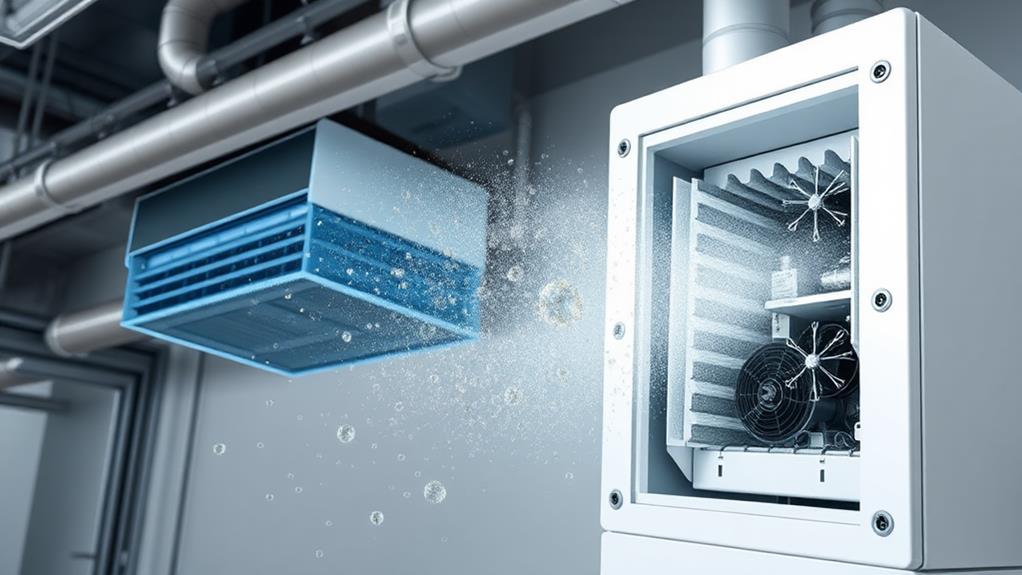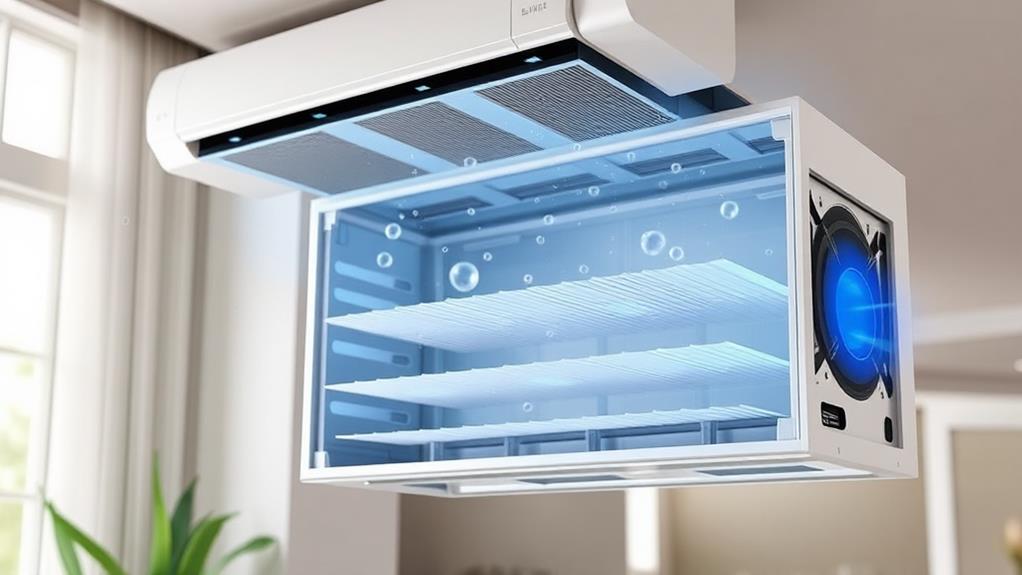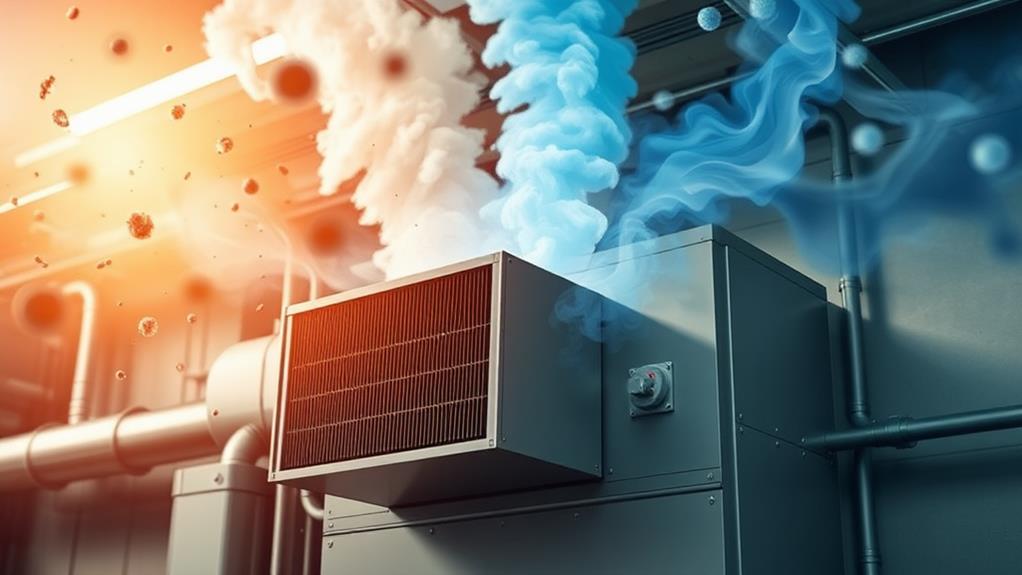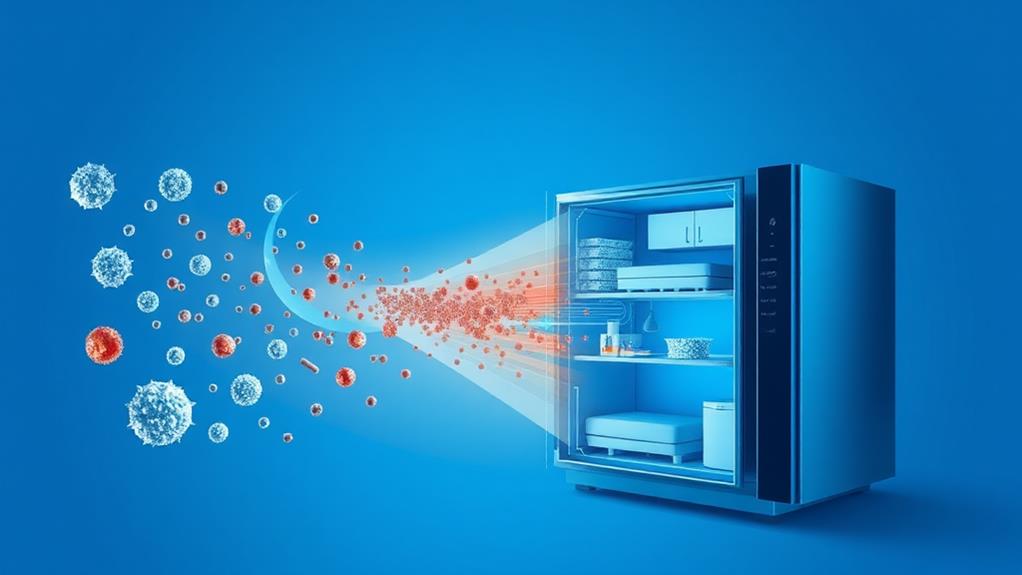Air purifiers integrated into HVAC systems play a vital role in enhancing indoor air quality and system efficiency. They capture and eliminate various airborne contaminants, including dust, pollen, bacteria, and viruses. You'll find different types of purifiers, such as mechanical filters, UV-C light purifiers, and ionizers, each targeting specific pollutants. By incorporating these devices, you'll enjoy improved air quality, reduced maintenance costs, and potential energy savings. Proper installation and regular maintenance are crucial for optimal performance. As technology advances, you can expect smarter, more efficient purification systems that seamlessly integrate with your HVAC setup. Exploring the specifics will help you make informed decisions about your indoor air quality management.
Understanding HVAC Air Purification

Many homeowners and building managers don't realize that HVAC systems can do more than just regulate temperature. These systems also play a crucial role in maintaining indoor air quality, especially when equipped with air purification components.
HVAC air purification involves the integration of filtration and cleaning technologies directly into your heating, ventilation, and air conditioning system.
You'll find that HVAC air purifiers work by capturing and eliminating various airborne contaminants as air circulates through your system. These contaminants include dust, pollen, pet dander, mold spores, and even some bacteria and viruses. The most common type of air purifier in HVAC systems is the mechanical filter, which uses a dense mesh to trap particles. More advanced options include electronic air cleaners, UV light purifiers, and activated carbon filters.
Types of HVAC Air Purifiers
HVAC systems offer a variety of air purifier options to suit different needs and environments. You'll find several types of air purifiers commonly used in HVAC systems, each with its own strengths and applications.
Mechanical filters, including HEPA filters, are popular choices. They trap particles as air passes through, effectively removing dust, pollen, and other allergens. Activated carbon filters excel at eliminating odors and volatile organic compounds (VOCs). For those concerned about microorganisms, UV-C light purifiers use ultraviolet radiation to neutralize bacteria, viruses, and mold spores.
Electrostatic precipitators create an electric charge to attract and capture airborne particles. They're effective for smoke and fine dust. Ionizers release negatively charged ions to attach to pollutants, making them too heavy to remain airborne. Photocatalytic oxidation (PCO) purifiers use UV light and a catalyst to convert harmful pollutants into harmless substances.
Some HVAC systems incorporate multiple purification methods for comprehensive air cleaning. When choosing an air purifier, consider factors like the specific pollutants you're targeting, your budget, and maintenance requirements. It's also important to ensure the purifier is compatible with your existing HVAC system for optimal performance.
Benefits of Integrated Air Purifiers

Integrating air purifiers into HVAC systems offers numerous advantages for homeowners and businesses alike. You'll experience improved indoor air quality as these systems effectively remove pollutants, allergens, and harmful particles from the air you breathe. This can lead to better respiratory health and reduced allergy symptoms for occupants.
Integrated air purifiers also enhance the overall efficiency of your HVAC system. By capturing dust and debris, they prevent these particles from accumulating on your system's components, resulting in less wear and tear. This means you'll likely see lower maintenance costs and a longer lifespan for your HVAC equipment.
You'll appreciate the energy savings that come with integrated air purifiers. They work in tandem with your existing system, eliminating the need for separate, energy-consuming standalone units. Additionally, cleaner air allows your HVAC system to operate more efficiently, potentially reducing your energy bills.
Another benefit is the space-saving aspect. Integrated purifiers don't require extra floor space, keeping your living or working areas clutter-free. They're also typically quieter than standalone units, providing cleaner air without disturbing noise.
Installation and Maintenance Considerations
Homeowners considering integrated air purifiers should be aware of several installation and maintenance factors. First, you'll need to assess your HVAC system's compatibility with the chosen air purifier. Some models may require modifications to your existing ductwork or electrical systems. It's crucial to hire a certified HVAC professional for installation to ensure proper integration and optimal performance.
During installation, the technician will determine the best location for the purifier, typically near the air handler. They'll also seal any air leaks in the ductwork to maximize efficiency. You should expect some downtime during installation, which can take several hours depending on the complexity of your system.
Maintenance is key to keeping your integrated air purifier functioning effectively. You'll need to replace filters regularly, usually every 6-12 months, depending on usage and air quality. Some systems may require additional maintenance, such as UV lamp replacement or cleaning of ionization components. It's advisable to schedule annual professional inspections to ensure all components are working correctly and to address any potential issues before they become major problems.
Energy Efficiency and Cost Analysis

When considering the addition of an air purifier to your HVAC system, it's crucial to evaluate both energy efficiency and cost implications. Air purifiers can increase your system's energy consumption, potentially raising your utility bills. However, many modern purifiers are designed with energy efficiency in mind, utilizing advanced technologies to minimize power usage.
You'll want to look for Energy Star-certified models, which meet strict energy efficiency guidelines set by the EPA. These units typically consume 20-30% less energy than standard models. Consider the MERV rating of the filter as well; higher MERV ratings offer better filtration but may require more energy to push air through.
Factor in the initial cost of the purifier and ongoing expenses for filter replacements and maintenance. While there's an upfront investment, you may see long-term savings through improved HVAC efficiency and reduced wear on your system. Additionally, better air quality could lead to fewer health-related expenses.
To maximize cost-effectiveness, choose the right size purifier for your space and maintain it properly. Regular cleaning and timely filter replacements will ensure optimal performance and energy efficiency.
Indoor Air Quality Standards
Air quality standards serve as crucial benchmarks for maintaining healthy indoor environments. When you're considering air purifiers for your HVAC system, it's essential to understand these standards and how they impact your indoor air quality.
The Environmental Protection Agency (EPA) has established guidelines for common indoor air pollutants, including particulate matter, carbon monoxide, and volatile organic compounds (VOCs). You'll want to ensure your air purifier meets or exceeds these standards. The American Society of Heating, Refrigerating and Air-Conditioning Engineers (ASHRAE) also provides recommendations for ventilation rates and acceptable indoor air quality.
To comply with these standards, you'll need to consider factors such as the size of your space, occupancy levels, and potential sources of pollutants. You should also be aware of specific regulations that may apply to your building type, such as healthcare facilities or schools.
When selecting an air purifier, look for certifications from organizations like the Association of Home Appliance Manufacturers (AHAM) or the California Air Resources Board (CARB). These certifications indicate that the purifier has been tested and meets specific performance criteria for removing pollutants from the air.
Common Pollutants Addressed

Pollutants lurk in every corner of your indoor environment. Air purifiers integrated into HVAC systems target a wide range of contaminants to improve your air quality. These systems effectively combat particulate matter, including dust, pollen, and pet dander, which can trigger allergies and respiratory issues. They're also adept at removing volatile organic compounds (VOCs) emitted from household products, paints, and furniture.
Mold spores and bacteria, common in damp environments, are another focus of air purification systems. By trapping these microorganisms, purifiers help prevent the spread of airborne diseases and reduce mold-related health risks. Tobacco smoke, a persistent indoor pollutant, is also addressed by many air purifiers, which can capture both particles and gases associated with smoking.
Some advanced systems target specific pollutants like formaldehyde, often found in building materials, and radon, a naturally occurring radioactive gas. Carbon monoxide, while primarily managed by dedicated detectors, can also be reduced by certain air purification technologies. By addressing these common pollutants, air purifiers play a crucial role in maintaining a healthier indoor environment and supporting your overall well-being.
Future Trends in HVAC Purification
As technology continues to advance, the future of HVAC purification looks increasingly innovative and efficient. You'll see a rise in smart, connected air purifiers that integrate seamlessly with your home automation systems. These devices will use artificial intelligence to analyze air quality in real-time and adjust their performance accordingly.
Nanotechnology will play a significant role in developing more effective filtration materials. You can expect filters that can capture even smaller particles and neutralize more types of pollutants. UV-C light technology will become more widespread, offering enhanced germicidal capabilities within HVAC systems.
Energy efficiency will remain a top priority. You'll find purifiers that use less power while delivering better results. Manufacturers will also focus on developing eco-friendly filters that are biodegradable or made from sustainable materials.
Air quality monitoring will become more sophisticated. You'll have access to detailed reports about your indoor air quality, including breakdowns of specific pollutants and recommendations for improvement. This data will help you make informed decisions about your home's air quality management.
Lastly, you'll see a trend towards modular HVAC systems that allow for easy integration of various purification technologies, giving you more control over your indoor air quality.
Conclusion
You've now explored the vital role air purifiers play in HVAC systems. From improving indoor air quality to addressing common pollutants, these devices are essential for modern living. But have you considered the long-term benefits? With proper installation and maintenance, you'll enjoy cleaner air, enhanced energy efficiency, and potentially lower healthcare costs. As technology advances, expect even more innovative purification methods. Don't wait—start breathing easier by integrating air purification into your HVAC system today.

